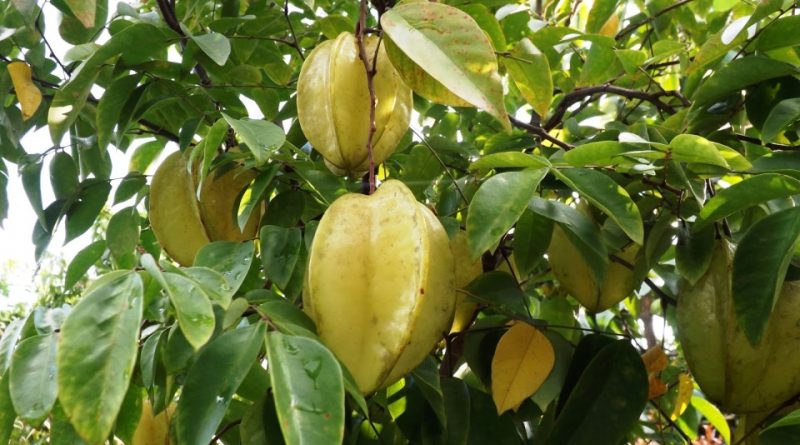Averrhoa carambola
Averrhoa carambola
The Carambola (Averrhoa carambola L.) is an arboreal species belonging to the Oxalidaceae family.
Systematic –
From the systematic point of view it belongs to the Domain Eukaryota, Kingdom Plantae, Phylum Tracheophyta, Infraphylum Angiospermae, Class Magnoliopsida, Sottoclasse Rosidae, Order Oxalidales, Family Oxalidaceae and therefore to the Averrhoa genus and to the A. Carambola species.
Etymology –
The term Averrhoa was attributed in honor of Averroes, the Latinized name by which the philosopher, jurist, physician and Arab astronomer of Spain, Abū l-Walīd Muḥammad ibn Rushd (Cordova 1126 – Marrākesh 1198) is known in the West. The specific carambola epithet comes from the identical Portuguese word, derived from carambal in Marathi, the Indian language of the Mumbai area.
Geographic Distribution and Habitat –
The Averrhoa carambola is a plant native to the area corresponding to Sri Lanka, India and the Moluccan Islands; today it is widespread throughout Southeast Asia and is also cultivated in Brazil, Ghana, Guyana and French Polynesia.
Description –
The Averrhoa carambola is an arboreal species endowed with a robust and deep root system, an upright trunk more than 2 meters tall and a broad and densely branched broad crown. The leaves are deciduous, alternate and smooth, green in color and are composed of ovate or elliptic leaves.
The flowers are long cluster-like inflorescences of red-violet color that appear in the intersections of the leaf axils.
The fruits are large and oblong with an oval shape with five pointed lobes arranged vertically along the surface, with a fragrant and shiny peel and light yellow-orange when it reaches maturity. The peel contains a juicy pulp with a sweet or sour taste, typical of pineapple and plums. The taste of carambola varies depending on the content of oxalic acid. Inside the pulp are small edible seeds of dark color and oblong shape. All parts of the fruit are edible.
Cultivation –
The Carambola is a very delicate plant, typical of tropical climates, but that in Italy can be grown in Sicily where it can also produce in the open field if sheltered well. In suitable climatic conditions, as in Malaysia, it blooms and bears fruit all year round, therefore flowers, unripe fruits and ripe fruits are present on the tree at the same time. In subtropical areas, on the other hand, the fruits ripen in autumn.
For the cultivation it requires sunny exposures for many hours a day and sheltered from the winds and from the frost and prefers the silty and sub-acid soils, with constant and abundant irrigations in all the periods of the year, except for the rainy season. The carambola reproduces by seed, by cutting and by grafting. For details of the cultivation technique refer to the following sheet.
Uses and Traditions –
Averrhoa carambola is a plant grown today in Brazil, Colombia, Ghana, Guyana, French Polynesia and recently also in Guam and Hawaii. This plant produces characteristic yellow fruits, also called star fruits or star – fruit, due to the similarity to the star when they are sliced transversely.
The fruit, at optimum ripeness, has a nice orange-yellow color and in the places of origin it is also consumed green, squeezed in dishes like a lemon or sliced in salads. The taste of carambola is a mixture of different fruits, such as lemon, pineapple and plum.
There are two varieties of carambola: sour and sweet; the latter is exported to Italy, especially during the Christmas period. Thanks to its original shape, it is used as a garnish in pastry and in the preparation of drinks with an exotic taste. The liqueurs are distilled from the carambola juice, while the pulp can also be turned into candied fruit.
The fruit of Carambola contains phenols and flavonoids, such as gallic acid, catechins, epicatechin and proanthocyanins and has been used in traditional medicine for the treatment of certain pathological conditions, such as headache, nausea, cough, insomnia, hypertension and diabetes.
According to the local people of French Guiana the exaggerated intake of this fruit can create kidney problems.
Preparation Mode –
The fruit of Carambola, in places of origin, is also consumed green, squeezed in dishes like a lemon or sliced in salads; it is also good as a candy and to garnish cakes. It is also used, as well as for garnishing in pastry, in the preparation of drinks with an exotic taste. From the distillation of Carambola juice you get some delicious liqueurs that are distilled from carambola juice.
Guido Bissanti
Sources
– Acta Plantarum – Flora of the Italian Regions.
– Wikipedia, the free encyclopedia.
– Treben M., 2000. Health from the Pharmacy of the Lord, Advice and experience with medicinal herbs, Ennsthaler Publisher
– Pignatti S., 1982. Flora d’Italia, Edagricole, Bologna.
– Conti F., Abbate G., Alessandrini A., Blasi C. (edited by), 2005. An annotated checklist of the Italian vascular flora, Palombi Editore.
Warning: Pharmaceutical applications and alimurgical uses are indicated for informational purposes only and do not in any way represent a medical prescription; there is therefore no liability for their use for curative, aesthetic or food purposes.


